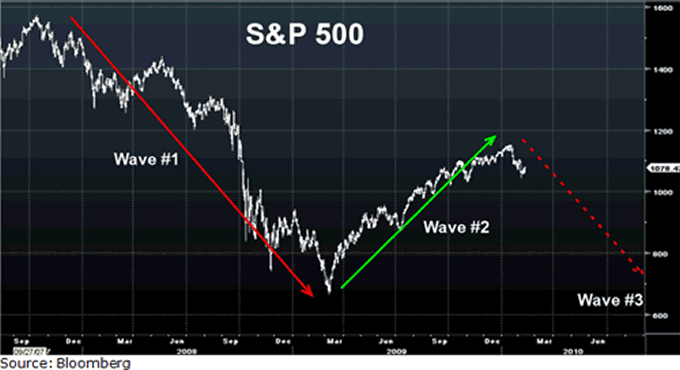Stocks Bear Market Resumes, Risk Aversion Final Wave
Stock-Markets / Stocks Bear Market Feb 14, 2010 - 08:53 AM GMTBy: Bryan_Rich
 Over the past months I’ve written extensively in my Money and Markets columns about the bubbling over of the risk trade. I also warned about the rising threats that would likely make a sustainable recovery, at this point, a low probability.
Over the past months I’ve written extensively in my Money and Markets columns about the bubbling over of the risk trade. I also warned about the rising threats that would likely make a sustainable recovery, at this point, a low probability.
And as time passes, we’re beginning to see that these threats, including a growing sovereign debt crisis, rising protectionism, and threatening asset bubbles, are becoming ripe and dangerous.
But in a world of instant information, it’s easy for our focus to be drawn away from the underlying fundamental problems in the world economy …
It can be difficult to see the forest for the trees when stock markets are rising, commodity prices are recovering and the media is touting hot burgeoning world economies.
But if you step back and examine the activities in the global economy and the global financial markets over the past 2½ years, based on history it looks like the roadmap to sustainable recovery has three waves. And we’re likely only two-thirds of the way through the economic drawdown.
Wave #1: Panic
Wave number one was panic-induced, risk aversion. It was the unraveling of the credit bubble, the seizing of the financial system and the flight of capital from all corners of the world back toward the center (the United States).
Wave #2: Stabilization
 |
| Risk appetite returned when central bankers blanketed the world with easy money. |
The second wave was the eye of the storm. Here, risk appetite bounced back. Global central banks engaged the biggest experiment in history in an effort to stabilize a rapidly deteriorating financial system. In the process, they opened up the money spigot and flooded banks with capital, backstopped failing giants, guaranteed obligations, and printed trillions of dollars.
For many, this started looking more and more like the recovery phase. But in reality, it was nothing more than a retracement of the initial, panic-induced risk aversion trade.
Wave #3: Pain & Cleansing
The final wave is another bout with pain. This is where all of the underlying problems come home to roost. Ultimately the problems get faced and worked through, only after which a path to a sustainable economic expansion opens.
This phase is best described as the final leg of the risk aversion trade. This is where global investors, again, flee for safety as the uncertainty elevates surrounding the fallout from damaged economies and the ability of central banks to manage all of the aggressive policy responses.
Here, investors abandon the pursuit of return ON capital, in favor of return OF capital. And this is precisely what we’re seeing now in response to the dominoes lining up with sovereign debt problems.
 |
| The final phase will be a time of higher savings and flight back to the U.S. dollar. |
It’s also a period that begins the healing of economies. And it’s driven by austerity. This means increased taxes, higher savings and a lower standard of living. In short, it’s a period of rebalancing and rebuilding.
A Technical View …
The three-phase cycle I just described is nothing new. It follows a time-tested theory on the behavior of markets and human psychology called Elliott waves. This principle suggests that patterns in markets tend to form five-wave and three-wave structures.
The five-wave structure is the dominant trend (i.e. economic expansion), and the three-wave structure is the corrective trend (economic downturn). My analysis suggests the recent downturn carries the three-wave, corrective characteristic.
Let me simplify this for you …
A good proxy for global risk appetite has been the U.S. stock market. This is where global risk taking, or lack thereof, is among the most easily identified.
When investors shy away from risk, the stock market tends to fall. When investors embrace risk, the stock market usually rises.

In the chart above, it’s easy to see the first two waves that I’ve laid out: Wave #1 — Panic; Wave #2 — Stabilization.
Admittedly, Wave #3 — Pain & Cleansing, is highly debatable. But if I’m right, it could be the phase that finally flushes out the landmines in the global economy and puts us back on a sustainable path of growth.
How this Impacts Currencies …
This third wave supports the thesis that I’ve been writing about for months in this column. That is, market participants will become more averse to risk.
And it also supports my argument from last year that the U.S. dollar’s demise is greatly exaggerated.
In the greatest monetary experiment of all times, following the broadest and deepest downturn since the Great Depression, you can expect surprises.
We’ve seen those surprises with more frequency and growing intensity over the past two months — and there will be more to come.
As this third leg of risk aversion unfolds, the dollar will again continue to function as the safe parking place for global capital. Not because the U.S. is in superior economic condition, but purely because it’s the best alternative.
Regards,
Bryan
This investment news is brought to you by Money and Markets. Money and Markets is a free daily investment newsletter from Martin D. Weiss and Weiss Research analysts offering the latest investing news and financial insights for the stock market, including tips and advice on investing in gold, energy and oil. Dr. Weiss is a leader in the fields of investing, interest rates, financial safety and economic forecasting. To view archives or subscribe, visit http://www.moneyandmarkets.com.
© 2005-2022 http://www.MarketOracle.co.uk - The Market Oracle is a FREE Daily Financial Markets Analysis & Forecasting online publication.



